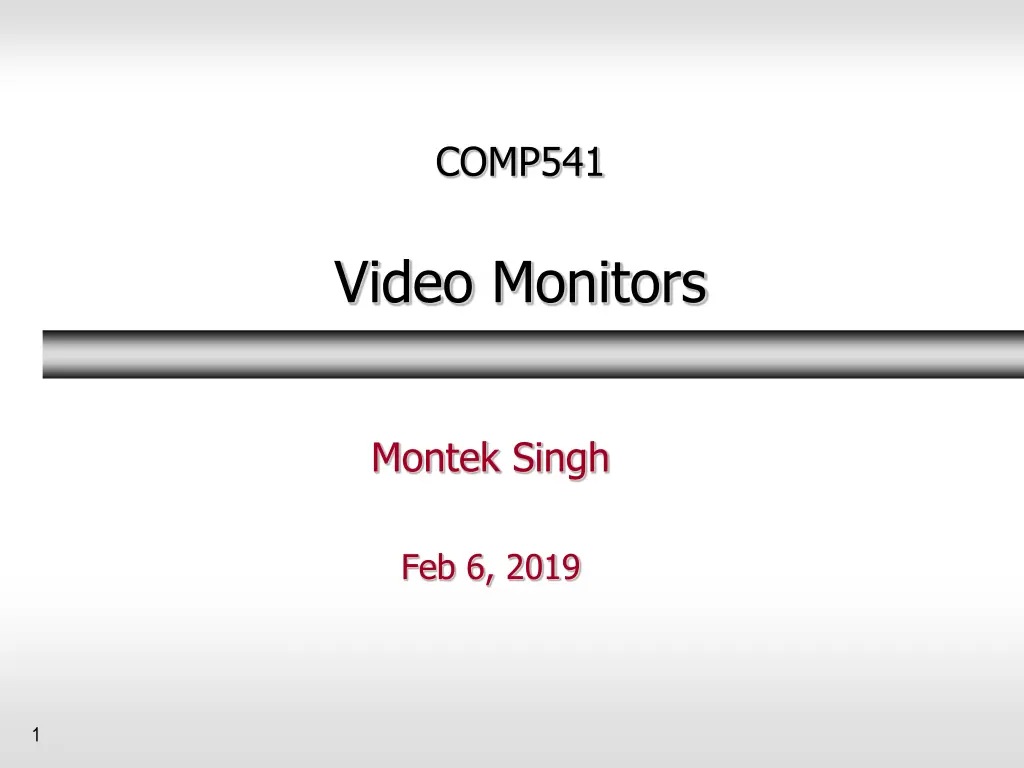
Understanding How Monitors Work: Insights from COMP541 Video by Montek Singh
Delve into the fascinating world of monitors as explained in the COMP541 video by Montek Singh. Explore the principles behind VGA displays, the functioning of CRTs, color phosphors, scanning methods, and more. Gain insights into the workings of LCD monitors and micro-mirror projectors, highlighting the evolution of display technologies.
Download Presentation

Please find below an Image/Link to download the presentation.
The content on the website is provided AS IS for your information and personal use only. It may not be sold, licensed, or shared on other websites without obtaining consent from the author. If you encounter any issues during the download, it is possible that the publisher has removed the file from their server.
You are allowed to download the files provided on this website for personal or commercial use, subject to the condition that they are used lawfully. All files are the property of their respective owners.
The content on the website is provided AS IS for your information and personal use only. It may not be sold, licensed, or shared on other websites without obtaining consent from the author.
E N D
Presentation Transcript
COMP541 Video Monitors Montek Singh Feb 6, 2019 1
How Do Monitors Work? Origin is TV, so let s look at that LCDs work on different principle, but all signaling still derived from TV of 1940s Relies on your brain to do two things Integrate over space Integrate over time 3
Many Still Images Video (and movies) are a series of stills If stills go fast enough your brain interprets as moving imagery 50-60 Hz or more to not see flicker 1 Hz means once per second In fact, even if the scene does not change a single still image is displayed repeatedly over time Why? Phosphor persistence varies 4
Cathode Ray Tube (CRT) From wikipedia: http://en.wikipedia.org/wiki/Cathode_ray_tube 5
Simple Scanning TV Electron beam scans across Turned off when Scanning back to the left (horizontal retrace ----) Scanning to the top (vertical retrace ____) 7
Scanning: Interlaced vs. Progressive (Some) TVs use interlacing Every other scan line is swept per field Two fields per frame (30Hz) Way to make movement less disturbing Computers use progressive scan Whole frame refreshed at once 60Hz or more, 72Hz looks better Similar notation used for HD i = interlaced (1080i) p = progressive (1080p) which better? 8
Color Three colors of phosphor three beams, one each for the three phosphors Black: all beams off White: all beams on Mask (or aperture grill) ensures beams hit only correct color phosphor. 9
What about LCD? How do LCD monitors work? internals are very different no beams, tubes made up of tiny LCD cells However, external signaling is the same! for compatibility Same goes for micro-mirror projectors tiny mirrors (one/pixel) that allow light through or send it out of the way possible to change pixels selectively 10
VGA Signaling Timing signals horizontal sync (hsync) & vertical sync (vsync) Color values: R, G, B total 8 bits for Nexys 3 (rrrgggbb), 12 bits for Nexys 4 (rrrrggggbbbb) digital to analog converter Nexys 4 11
VGA Timing You supply two pulses hsync and vsync allow the monitor to lock onto timing One vsync per frame One hsync per scan line hsync does not stop during vsync pulse Image from dell.com 12
Horizontal Timing Terms Horizontal timing: hsync pulse Back porch (left side of display) Active Video Video should be blanked (not sent) at other times Front porch (right side) 13
Horizontal Timing This diagram shows video as a digital signal. It s not video is an analog level. 640 Horizontal Dots Horiz. Sync Polarity NEG Scanline time (A) 31.77 us Sync pulse length (B) 3.77 us Back porch (C) 1.89 us Active video (D) 25.17 us Front porch (E) 0.94 us us = microsecond Image from http://www.epanorama.net/documents/pc/vga_timing.html 14
Vertical Timing (note ms, not us) Vert. Sync Polarity NEG Vertical Frequency 60Hz Total frame time (O) 16.68 ms Sync length (P) 0.06 ms Back porch (Q) 1.02 ms Active video (R) 15.25 ms Front porch (S) 0.35 ms 15
Timing as Pixels Easiest to derive all timing from single-pixel timing How long is a pixel? Active video / number of pixels 25.17 us / 640 = 39.32ns Conveniently close to 25 MHz just use that Actual VESA spec is 25.175 MHz 16
The overall picture (Picture from http://www.pyroelectro.com) 17
Standards 640 x 480 (sometimes x 60Hz) is VGA I will give you spec sheets in lab 800x600 at 60 Hz (40 MHz exactly) or 800x600 at 72 Hz (50 MHz exactly) Note that some standards have vsync and hsync positive true, some negative true choose correct polarity determine by experimentation! 18
Color Depth Voltage of each of RGB determines color Nexys 4: 4-bit for red, green and blue All on for white Nexys 4 19
Lab (VGA Displays) Make Verilog module to generate hsync, vsync, horizontal count, vertical count, and signal to indicate active video Use higher-level module to drive RGB using counts gated by active Just do something simple (stripes, checkerboard, diagonals) Try to produce the pattern given on the website Later we will use memory addressed by counts to make a terminal 1. 2. 3. Notes: Be careful about the Sync Polarity A 1 means a downward going pulse sync signal is normally high, but goes low during the pulse A 0 means an upward going pulse Use my self-checking text bench! simulates my VGA driver and compares your outputs with mine flags any mismatches 20
What do you need for VGA? Think first Need counter(s)? Will you need a state machine? Sketch out a design Block diagram Test individually in lab Keep in mind Verilog has all these operators (and more; see Verilog ref.) ==, <, >, <=, >= 21
VGA Links VGA Timing Recommended: http://tinyvga.com/vga-timing http://www.epanorama.net/documents/pc/vga_timing.html Interesting http://www.howstuffworks.com/tv.htm http://computer.howstuffworks.com/monitor.htm http://www.howstuffworks.com/lcd.htm http://plc.cwru.edu/ 22
